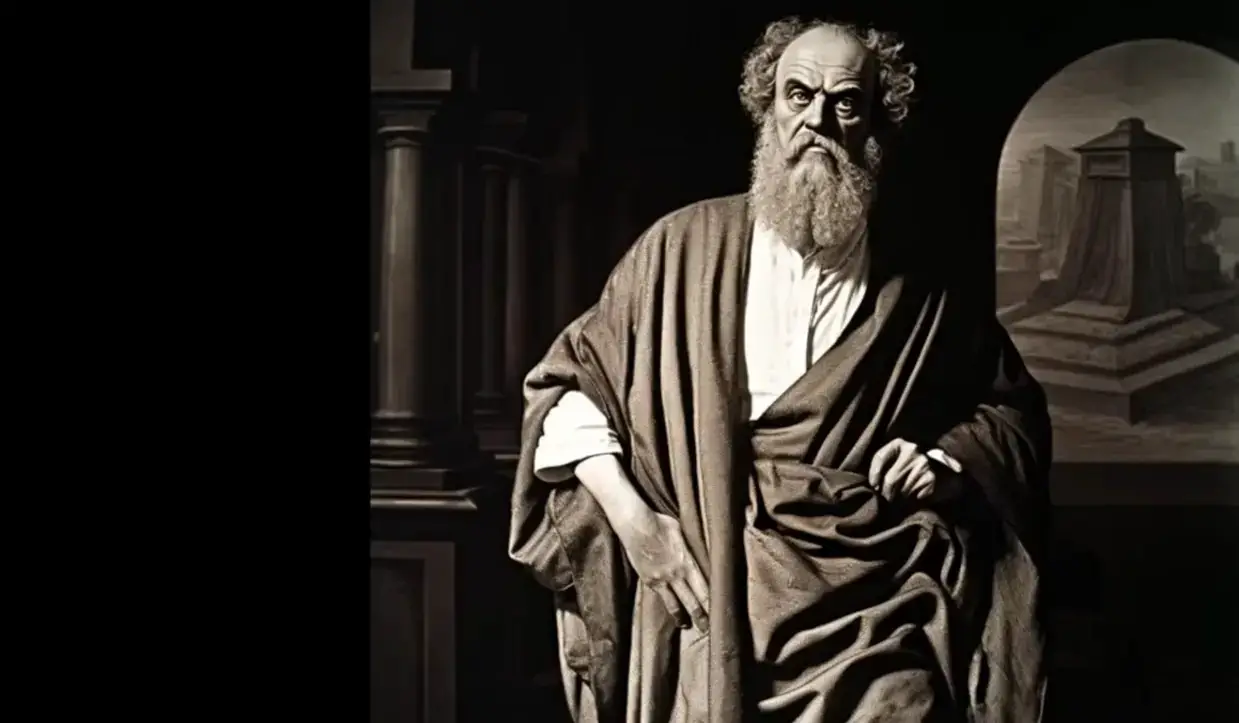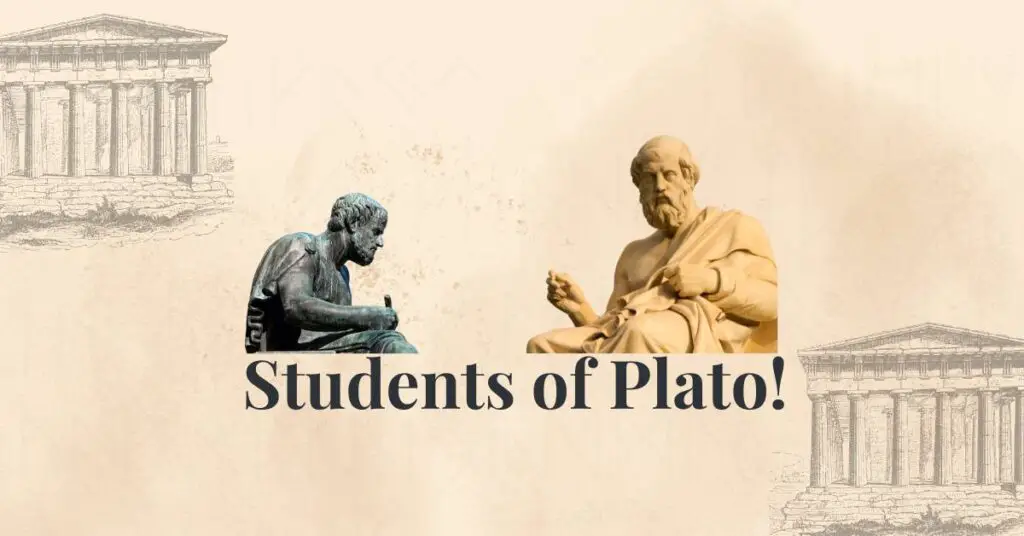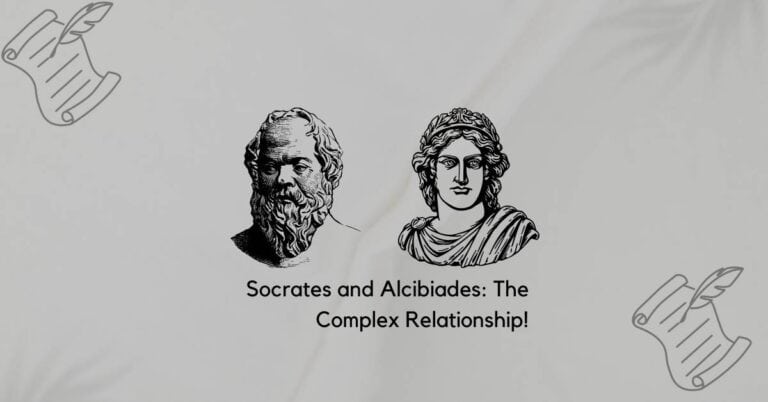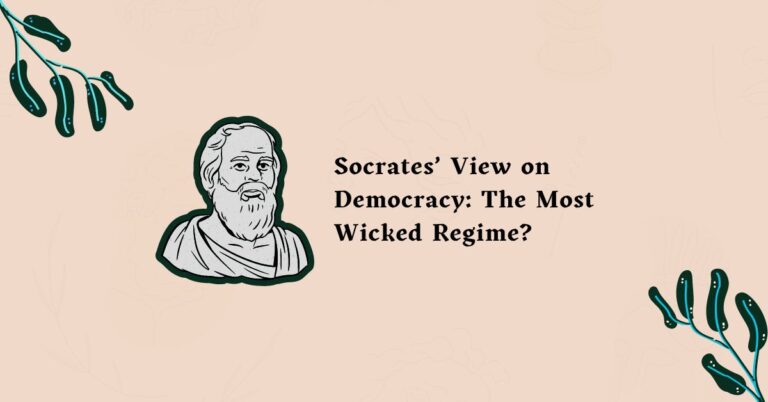Students of Plato: Elite 4 and Influential Elders!
There is no denying that Plato was one of the most influential thinkers in Western philosophy. He was one of the most notable students of Socrates. Besides, he was the teacher of Aristotle, who is widely considered as one of the greatest philosophers of all time!
Picture Plato as the headmaster of the Academy in Athens, an intellectual hotspot where thinkers gathered like bees to honey. Now, why bother about his students, you ask? Well, learning about the lives, philosophies, and legacies of Plato’s protégés is like unlocking a treasure chest of wisdom.
It shows us how the seeds planted by Plato blossomed into diverse philosophical landscapes. In this blog, you’ll see how these brilliant minds shaped ideas that still is relevant to this day.
The Importance of Plato’s Students
Plato wasn’t just a brilliant thinker; he was also a gifted teacher. His Academy, founded in 387 BCE, became a breeding ground for philosophical discourse. And his students played a crucial role in shaping the course of Western thought. Below, we have described how they contributed to the world of philosophy.
Spreading the Ideas Plato:
Plato’s students didn’t simply absorb his teachings – they actively engaged with them, debated them, and carried them forward.
Thinkers like Aristotle, perhaps Plato’s most famous student, took core Platonic concepts and built upon them, forming their distinct philosophies.
This created a rich intellectual tapestry, with each student adding a new thread to the philosophical conversation.
Different Thoughts of Plato’s Students:
Plato’s Academy wasn’t an echo chamber. Some students, like Xenocrates, became torchbearers for core Platonic ideas.
But, his other students like Speusippus, diverged in significant ways. This intellectual diversity ensured that Plato’s philosophy wasn’t ossified, but rather remained a vibrant and evolving tradition.
Safeguarding the Legacy:
Plato’s writings, primarily in the form of dialogues featuring Socrates, were unusual for their time. They weren’t systematic treatizes but rather explorations of ideas through conversation. It’s thanks to his students, who meticulously preserved and copied these dialogues, that we have access to Plato’s thought today.
Navigating the Dialogues:
Plato’s dialogues can be challenging. They often feature Socrates engaging in open-ended inquiries, leaving some questions unanswered.
Here, Plato’s students played a vital role as interpreters. They wrote commentaries and analyses, helping others understand the nuances of Plato’s arguments and the underlying philosophical concepts.
4 Noted Students of Plato and Their Contributions
1. Aristotle
Early Life: Born in 384 BCE in Stagira, Greece, Aristotle came from a family with a tradition of medicine. His father, Nicomachus, was the personal physician to King Amyntas III of Macedon.
At the age of 17, Aristotle traveled to Athens to enroll in Plato’s Academy. He remained there for nearly two decades, immersing himself in Platonic philosophy, logic, and mathematics.
Philosophical Differences: While deeply influenced by Plato, Aristotle developed distinct philosophical views:
- Theory of Forms: Plato believed in a realm of perfect Forms, the ideal versions of everything in the physical world. Aristotle rejected this, arguing that universals (general concepts) exist only within particular objects.
- Epistemology (Theory of Knowledge): For Plato, knowledge came from a recollection of the Forms. Aristotle countered that knowledge comes from observation and experience of the natural world.
- Founding the Lyceum: After Plato’s death in 347 BCE, Aristotle left Athens and established his own school, the Lyceum. Here, he emphasized empirical observation and scientific inquiry.
Lasting Impact: Aristotle’s contributions were profound:
- Logic: He developed a system of formal logic that remains the foundation of Western logic today. His work on syllogisms (deductive reasoning) provided a framework for clear and rigorous argumentation.
- Metaphysics: He explored the nature of reality, existence, and first principles. His concept of “prime mover” (unmoved mover) laid the groundwork for later ideas about God.
- Natural Sciences: Aristotle’s detailed observations of nature in biology, zoology, and physics laid the groundwork for scientific inquiry for centuries. While some of his specific observations were later shown to be inaccurate, his emphasis on systematic observation and classification was groundbreaking.
Though a student of Plato, Aristotle became a philosophical giant in his own right. His emphasis on logic, observation, and the natural world profoundly influenced Western thought and laid the foundation for scientific exploration.
2. Speusippus

Speusippus was Plato’s nephew and successor. He was the head of the Academy from 347-339 BC and played a crucial role in the development of Platonic philosophy.
While often overshadowed by his more famous contemporaries like Aristotle, Speusippus made significant contributions, particularly in the areas of knowledge and ethics. Here are some of his key contributions:
- Moving Beyond Forms:
Speusippus diverged from Plato’s theory of Forms. Plato posited a realm of perfect Forms existing independently of the physical world. Speusippus, however, proposed two fundamental principles: the One and the Indefinite Dyad.
The One represented unity and perfection, while the Dyad symbolized multiplicity and limitation. These principles interacted to create the physical world, suggesting a more dynamic system for understanding knowledge.
- Mathematics as a Bridge:
Speusippus emphasized the role of mathematics in bridging the gap between the One and the Dyad. He believed that mathematical concepts provided a key to understanding the order and structure of the universe, a notion that influenced later philosophers.
3. Xenocrates
Xenocrates of Chalcedon (c. 396/5 – 314/3 BCE) was a key figure among the students of Plato. He became a pivotal figure in shaping and systematizing Platonic philosophy.
Details about Xenocrates’ early life are scarce.
Born in Chalcedon (present-day Turkey), he likely traveled to Athens in his youth, drawn by the intellectual ferment of Plato’s Academy. His dedication and intellectual prowess earned him a prominent place among Plato’s students.
Architect of Platonic Metaphysics:
Xenocrates is credited with developing a more systematic framework for Plato’s metaphysical ideas. Here are some key aspects of his contribution:
- The Monad and the Dyad: He proposed two fundamental principles – the One (Monad) and the Indefinite Two (Dyad). The One represents unity, intellect, and the divine, while the Dyad embodies multiplicity and the material world. This system aimed to explain the relationship between the perfect realm of Forms and the imperfect physical world.
- Mathematical Infusion: Xenocrates, influenced by Pythagorean ideas, incorporated mathematics heavily into his metaphysics. He believed numbers acted as intermediaries between the Forms and the physical world, providing a structure and order to reality.
Ethical Compass:
Xenocrates’ ethical views aligned with Plato’s emphasis on virtue and reason. However, he offered some unique insights:
- Three Grades of Knowledge: He distinguished between three levels of knowledge: sense perception (lowest), opinion (intermediate), and knowledge (highest). Knowledge, achievable through reason, allows us to grasp the true nature of reality.
- Happiness Through Virtue: Like Plato, Xenocrates saw happiness as the ultimate goal. However, he placed more emphasis on reason as the guide to achieving happiness through virtue. External goods were seen as valuable only insofar as they contributed to a virtuous life.
Xenocrates’ systematic approach to Plato’s philosophy ensured its continued relevance in the centuries that followed. His emphasis on mathematics and reason in understanding the universe paved the way for later scientific developments.
4. Aeschines of Sphettus
Aeschines of Sphettus (c. 390 – c. 330 BCE), though not as renowned as some of Plato’s other students, played a vital role in preserving and disseminating Platonic thought.
After Plato’s death, Aeschines, along with Xenocrates, took on the crucial task of compiling and editing Plato’s dialogues.
Without Aeschines’ dedication, a significant portion of Plato’s thought might have been lost.
He was also a distinguished rhetorician in his own right. He achieved fame for his eloquence and persuasive abilities, even delivering a speech against his fellow student Demosthenes, another famous Athenian orator.
Lesser Know Pupils of Plato
Aristonymus of Athens (c. 360 – c. 300 BCE):
Aristonymus was a student of Plato and a writer. He is best known for his work “Lives of the Philosophers,” which is a collection of biographies of early Greek philosophers, including Pythagoras, Socrates, and Plato himself. Unfortunately, this work has not survived in its entirety, but fragments of it have been preserved in the writings of later authors.
Axiothea of Phlius (4th century BCE):
Axiothea was a woman who studied at Plato’s Academy. She is one of the few women known to have been associated with the Academy in its early years.
Some sources claim she disguised herself as a man to attend lectures. While the details of her life are sketchy, her presence challenges the traditional view of the Academy as an exclusively male institution.
Chaeron of Pellene (4th century BCE):
He was a student of Plato and a writer. He is known for his work “On Happiness,” which discussed Plato’s views on the nature of happiness. Unfortunately, like Aristonymus’ work, this work, too, has not survived in its entirety.
Chion of Heraclea (4th century BCE):
Chion was a philosopher and a student of Plato. He is known for his interest in dialectic, the method of philosophical inquiry that Plato emphasized. There is very little information available about his specific contributions to philosophy.
Coriscus of Scepsis (4th century BCE):
Coriscus was a pupil of Plato and a skeptic philosopher. Skepticism is a school of thought that doubts the possibility of achieving specific knowledge. Coriscus’ views are not well known, but he is believed to have been one of the founders of the skeptical tradition.
Demetrius of Amphipolis:
Demetrius of Amphipolis is an obscure figure in the history of philosophy. Little is known about his life or his philosophical contributions.
Like many of Plato’s students, it’s possible he contributed to the discussions and intellectual life of the Academy, Plato’s school in Athens. However, specific details about his work or teachings are scarce.
Erastus of Scepsis:
Erastus of Scepsis is another student about whom very little is known. The city of Scepsis, located in the Troad region (modern-day Turkey), was a centre of learning and culture in the ancient world.
Erastus likely contributed to the intellectual activities of his time, possibly in areas of philosophy or politics, but specific records of his contributions have not survived.
Euaeon of Lampsacus:
Euaeon of Lampsacus, like the others, remains a largely obscure figure in ancient philosophical tradition. Lampsacus was an ancient city located on the eastern side of the Hellespont. While specific details about Euaeon’s life and teachings are lacking, his connection to Plato suggests he was involved in the philosophical discourses of his time.
Eudoxus of Cnidus
Eudoxus of Cnidus is one of the more well-known students of Plato on this list. Born around 390 BC, Eudoxus was not only a philosopher but also a mathematician and astronomer.
He is best known for his work in geometry, particularly for his contributions to the theory of proportions and his method of exhaustion, which would later influence Euclid’s work.
Eudoxus also developed a sophisticated model of the universe that attempted to explain the movements of the planets through a series of concentric spheres.
Heracleodorus (4th century BCE):
Heracleodorus is not widely mentioned in historical sources, making detailed information about his life and contributions scarce.
Given the timeframe and the common practice of philosophers traveling and studying under different teachers, it’s plausible that Heracleodorus was involved in the intellectual discussions of his time, potentially contributing to the development or dissemination of Platonic philosophy.
Heraclides of Aenus:
Heraclides of Aenus, like many of his contemporaries, remains a figure shrouded in historical obscurity. Aenus, located in the region that is now part of Turkey, was an area of significant cultural and intellectual activity.
Though specific details about Heraclides’ contributions are lacking, his association with Plato’s Academy suggests that he might have been involved in philosophical discussions or teachings related to Plato’s work.
Hestiaeus of Perinthus:
Hestiaeus of Perinthus is another lesser-known figure. Perinthus, a city on the European side of the Sea of Marmara, was a significant center in ancient times.
As with many students of Plato, the specifics of Hestiaeus’s philosophical contributions or the exact nature of his studies under Plato are not well-documented in surviving texts.
Lastheneia of Mantinea:
Lastheneia of Mantinea is one of the few female figures known to have studied at Plato’s Academy, highlighting the inclusive aspect of Platonic philosophical education for its time. Mantinea was a city-state in the Peloponnese, Greece.
Lastheneia’s presence in the Academy suggests that Plato’s philosophical teachings reached a diverse audience.
Unfortunately, like many women in ancient philosophy, the specifics of her contributions and thoughts are not well-documented, though her status as a student of Plato speaks to her intellectual significance.
Python of Aenus:
Python of Aenus, originating from the same area as Heraclides of Aenus, is yet another figure about whom little specific information has survived.
His inclusion in lists of Plato’s students indicates his involvement in the philosophical circles of the time, though the details of his work, like those of many ancient philosophers, have largely been lost to history.
Timolaus of Cyzicus:
Timolaus of Cyzicus comes from Cyzicus, an ancient city located in what is now modern-day Turkey. As with the others, detailed accounts of his life and philosophical work are sparse.
His study under Plato at the Academy suggests he was engaged in the philosophical dialogues and teachings of the time, contributing in some way to the intellectual legacy of Platonic philosophy.
The Philosophical Schools and Thought Influenced by Plato’s Students
Plato’s legacy extended far beyond the walls of the Academy. His students, while deeply influenced by him, branched out to develop their own philosophical schools and ideas. Here’s a look at some key outgrowths:
1. Aristotle’s Lyceum:
Imagine two schools in ancient Greece, both started by brilliant thinkers. Plato’s Academy was like a finishing school for the mind, focusing on perfect, unchanging ideas.
Aristotle’s Lyceum was more hands-on, all about getting out there and observing the real world. Here’s the breakdown:
Theory of Forms: Plato believed in perfect versions of everything, like the perfect chair or the perfect circle. These were called Forms.
Aristotle wasn’t a big fan. He thought these perfect things existed within real objects, not separate from them. Think of a chair: the perfect chair might be an idea, but a real chair has that perfect chairness built right in.
Epistemology: Plato thought learning was like remembering. We used to know all this perfect stuff (the Forms) before birth, and school was just reminding us.
Aristotle said, “Hold on a sec!” He believed knowledge came from observing the world around us, not past-life memories. Think of learning to ride a bike. You don’t remember being a pro before you were born; you learn by getting on and trying (and maybe falling a few times).
Focus: Plato’s Academy was more about big ideas and ethics (how to live a good life). Aristotle’s Lyceum was all about science! They dissected animals, studied plants, and basically started the whole “looking at stuff to understand it” movement.
Logic: Both Plato and Aristotle liked logic, the science of good arguing. Plato built the foundation, and Aristotle built a whole new floor on top of it. We still use some of Aristotle’s logical ideas today!
Metaphysics: Plato had this “unmoved mover” idea, kind of like a giant cosmic push that started everything. Aristotle liked that idea, too, but he called it the “first mover.”
So, which school was cooler? That’s up to you! Did you prefer Plato’s world of perfect ideas or Aristotle’s focus on the real world?
2. Middle Platonism:
A Bridge Between Worlds: This movement (1st century BCE – 3rd century CE) aimed to reconcile Platonic thought with emerging philosophical currents like Stoicism and Skepticism.
- Stoicism (focuses on reason and living virtuously)
- Skepticism (questions the possibility of certain knowledge)
Key Figures: Figures like Antiochus of Ascalon and Plutarch reinterpreted Plato’s ideas, making them more accessible to a wider audience.
Emphasis on Ethics: Middle Platonism placed a greater focus on ethics and practical philosophy, applying Platonic principles to everyday life.
3. Neoplatonism:
A Resurgence of Mysticism: Emerging in the 3rd century CE, Neoplatonism revitalized Platonic thought with a strong emphasis on mysticism and the concept of the One, an ultimate source of all reality.
Key Figures: Plotinus, the founder of Neoplatonism, and his followers like Porphyry developed a complex system based on the One, the Nous (intellect), and the Soul.
Influence on Religion: Neoplatonism’s ideas on the One and the hierarchical structure of reality influenced Christian and Islamic theology.
These are just some of the schools and movements inspired by Plato’s students. Each contributed to the evolution and dissemination of Platonic thought, shaping the course of Western philosophy for centuries to come.
Conclusion:
Plato’s students weren’t just pupils; they were intellectual partners who actively engaged with his philosophy, shaping its course and ensuring its long-lasting impact. They diverged, debated, and built upon his ideas, creating a rich intellectual tapestry that continues to resonate today.
Key Takeaways:
- Plato’s students spread his ideas, ensured their preservation, and interpreted them in new ways.
- Figures like Aristotle and Speusippus established their own schools of thought, departing from but still influenced by Plato.
- Through Middle Platonism and Neoplatonism, Platonic ideas were reinterpreted and disseminated for centuries.
- Plato’s students’ legacy is evident in the development of logic, metaphysics, ethics, science, and educational systems.



